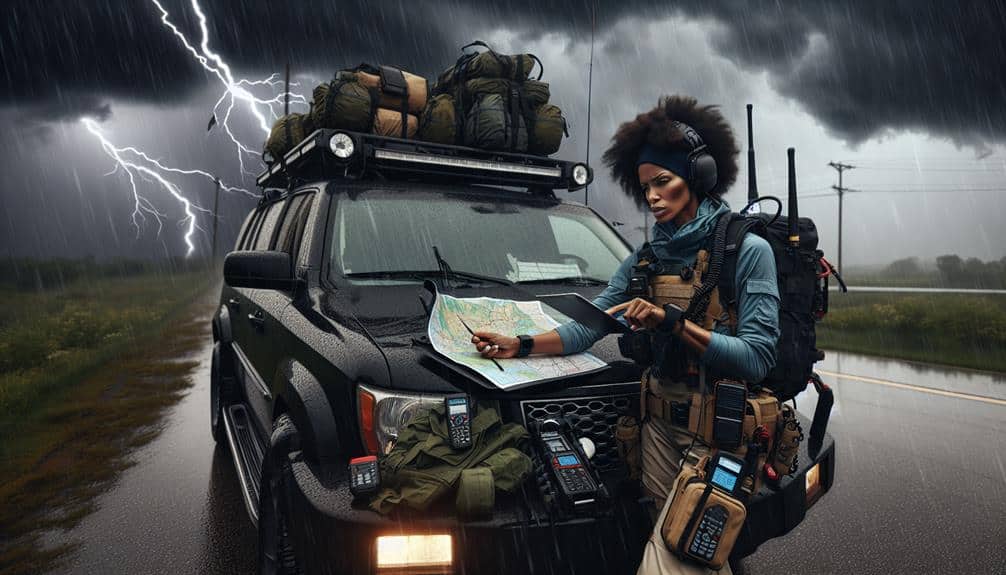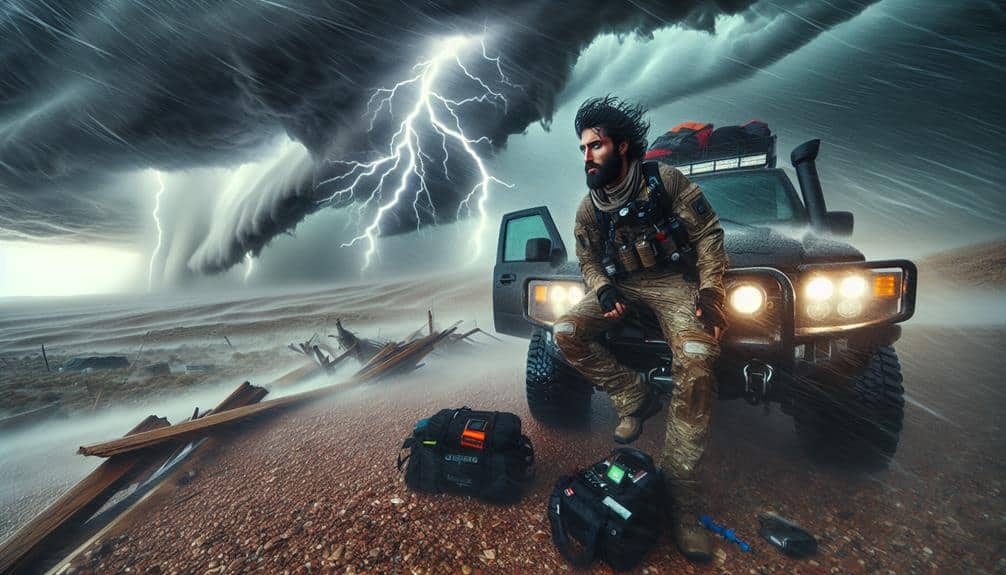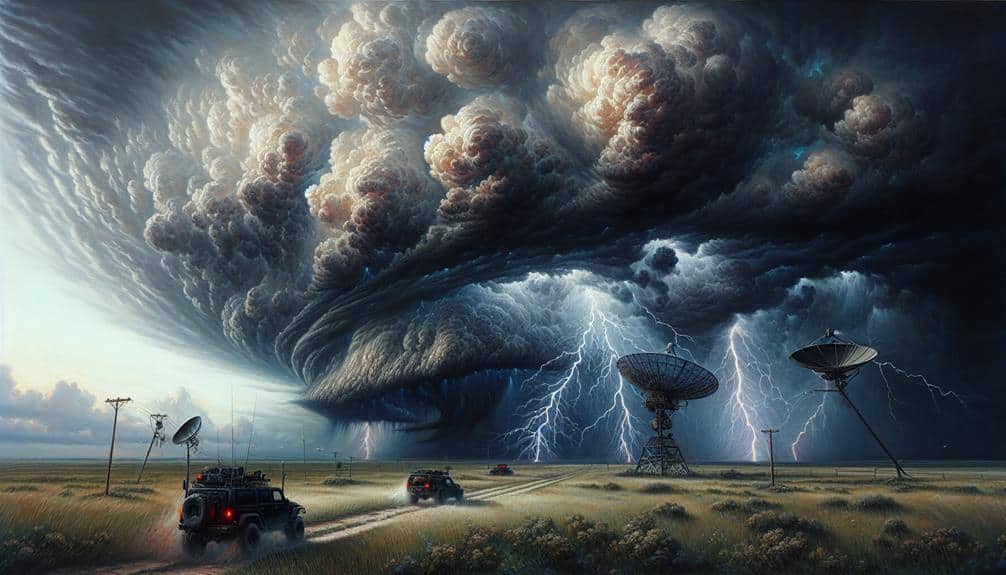We integrate real-time weather tracking, analyzing atmospheric pressure, temperature, and humidity to navigate storm dynamics. Our gear includes weatherproof clothing, satellite phones, GPS units, and portable shelters for ultimate safety. Routine vehicle maintenance, like checking tire pressure and fluid levels, guarantees reliability. During storms, we rely on advanced radar systems and Doppler data for precise route adjustments. Robust communication strategies involving satellite phones and structured protocols enhance team coordination. Emergency plans with mapped shelters and first aid kits are vital. By combining these strategies, we mitigate risks and maximize our chances of survival in unpredictable weather conditions. Discover our holistic approach further ahead.
Key Points
- Carry weatherproof clothing and emergency communication devices for safety.
- Regularly inspect vehicle tire pressure, fluid levels, and battery health to ensure reliability.
- Use advanced radar systems and satellite data for real-time weather tracking.
- Pre-identify and map emergency shelters along planned routes.
Understanding Storm Dynamics
To effectively chase storms, we must analyze the complex interactions of atmospheric pressure, temperature, and humidity that drive storm dynamics. These elements are essential in understanding storm formation, especially when it comes to severe weather phenomena like tornadoes, lightning strikes, and hailstorms. By examining pressure gradients, we can identify regions where the atmosphere is key for instability, which is a pivotal factor in the development of supercells and tornadoes.
Temperature differentials between air masses create fronts that can trigger storm formation. Warm, moist air rising into cooler, drier air often forms cumulonimbus clouds, leading to intense weather events. Humidity levels play a vital role in energy transfer within the storm system, directly impacting the likelihood of lightning strikes and hailstorms. High humidity provides the necessary moisture for hailstone formation as water droplets are lifted and frozen repeatedly in the updrafts.
In our pursuit of storm chasing, we rely on real-time data from weather models and Doppler radar to track these essential variables. By doing so, we enhance our ability to predict the development and trajectory of severe storms, enabling us to safely and effectively observe these powerful natural events.
Essential Gear Checklist
Armed with a comprehensive understanding of storm dynamics, we must now focus on assembling the essential gear that safeguards our safety and data accuracy during storm chasing missions. Packing essentials include weatherproof clothing, sturdy boots, and protective eyewear. These items are non-negotiable, ensuring we remain shielded from adverse conditions while maintaining mobility.
Next, emergency communication devices are necessary. We need multiple layers of communication, such as satellite phones, two-way radios, and reliable cellular devices to guarantee we're always in touch with our team and emergency services. Additionally, navigation tools like GPS units and detailed topographic maps are critical, enabling us to track storm paths accurately and avoid hazardous areas.
Our gear must also include portable storm shelters. These compact, durable structures can be lifesaving when we find ourselves in the direct path of a severe storm.
Data collection tools are another cornerstone of our kit. High-resolution cameras, anemometers, and barometers are essential for capturing detailed storm information.
Vehicle Preparation Tips
To maximize safety and efficiency during storm chasing, we must diligently prepare our vehicle. This includes equipping it with essential safety gear, performing thorough maintenance checks, and assembling a thorough emergency supplies kit.
Let's analyze these important aspects to guarantee our vehicle is storm-ready.
Essential Safety Equipment
Proper vehicle preparation is crucial for storm chasers to guarantee safety and reliability in unpredictable weather conditions. Before heading out, we must make sure our vehicle is equipped with essential safety gear. This isn't just about comfort; it's about survival.
First, we need to take into account proper attire. Storms can be cold, wet, and hazardous. Wearing moisture-wicking layers, waterproof outerwear, and sturdy boots can make a significant difference in our safety and comfort.
Second, an emergency strategy is non-negotiable. We should have a predetermined route, communicate our plan to someone outside the chase, and have a backup plan if conditions worsen. This plan should include designated meeting spots and emergency contact numbers.
To further enhance our safety, let's list the top three essential safety equipment items:
- First Aid Kit: This should include bandages, antiseptics, pain relief, and any personal medications.
- Emergency Communication Devices: A satellite phone or two-way radios make sure we stay connected even if cell networks fail.
- Tool Kit and Spare Tire: Basic tools for minor repairs and a spare tire can prevent being stranded in severe weather.
Maintenance and Inspections
An effective vehicle maintenance routine must include regular inspections of tire pressure, fluid levels, and battery health to maximize performance during storm chases. We need to make sure our tires are properly inflated and free from damage, as they're essential for maintaining traction on wet, slippery roads.
Routine checks of the oil, coolant, and brake fluids can prevent engine overheating and brake failure, both of which are critical when maneuvering through unpredictable weather conditions.
Regular maintenance also encompasses the inspection of windshield wipers and lights. Maintaining clear visibility is essential for safety, and functional wipers and lights are non-negotiable.
Additionally, we should routinely check the battery for corrosion and verify it holds a proper charge. A sudden battery failure in the middle of a storm could leave us stranded, compromising our safety.
Moreover, we must schedule time for routine repairs. This includes examining the undercarriage for any potential rust or damage caused by exposure to the elements.
These checks and repairs aren't just about maintaining vehicle performance—they are about guaranteeing our safety. By adhering to a strict maintenance schedule, we enhance our ability to chase storms effectively and safely.
Emergency Supplies Checklist
Equipping our vehicle with a detailed emergency supplies checklist is important for guaranteeing we're prepared for any unexpected situations during storm chases. By maintaining a well-stocked vehicle, we enhance our resilience and autonomy in unpredictable weather scenarios.
Key items to include are:
- Food rations: Non-perishable, high-energy food options, such as protein bars and canned goods, are essential. Data suggests that a minimum three-day supply per person is best for sustained energy and endurance.
- Shelter options: Portable shelters like tents or emergency blankets offer protection from the elements if we're forced to leave the vehicle. Statistics show that having reliable shelter can greatly reduce exposure risks and maintain body temperature in extreme conditions.
- First-aid kit: Inclusive kits should include bandages, antiseptics, and pain relievers. Analytical reviews indicate that a well-equipped first-aid kit can handle minor injuries and prevent complications until professional medical help is available.
In addition to these essentials, our checklist should encompass tools like a multi-tool, flashlight, and extra batteries, enhancing our capability to address mechanical issues or navigate in low-light conditions.
Real-Time Weather Tracking
Utilizing advanced radar systems and satellite data, we can track severe weather patterns in real time to enhance our storm chasing strategies. The integration of cutting-edge technology allows us to receive instantaneous weather alerts, which is critical for making informed decisions on the move. This technology not only increases our forecast accuracy but also helps us navigate the inherent challenges posed by unpredictable weather conditions.
Our primary tools include Doppler radar and satellite imagery, which provide high-resolution data on storm development, intensity, and trajectory. With these resources, we can pinpoint the exact locations of potential tornadoes, hailstorms, and other severe weather phenomena. Real-time data feeds enable us to adjust our routes dynamically, minimizing risk while maximizing observational opportunities.
However, even with sophisticated technology, challenges remain. Atmospheric variables can change rapidly, complicating our predictions and necessitating continuous monitoring. Despite these hurdles, the constant flow of data enhances our ability to make precise forecasts.
Safety Protocols to Follow

To safeguard our safety while storm chasing, we follow a thorough set of protocols designed to mitigate risks and enhance our operational efficiency. First, we establish robust communication plans to keep our team connected at all times. This ensures that everyone knows the location of emergency shelters and can react promptly if the weather conditions worsen unexpectedly.
We rely on advanced weather apps to provide real-time updates and alerts. These apps are essential for making informed decisions and adapting our strategy on the fly. Our team's safety training includes regular drills and simulations, teaching us how to handle various scenarios we might encounter in the field.
Here's a breakdown of our key safety protocols:
- Emergency Shelters: We pre-identify and map out emergency shelters along our planned routes. This enables us to quickly navigate to safety if a storm intensifies.
- Communication Plans: Our communication plans include regular check-ins and backup communication methods, safeguarding no one is ever out of contact.
- Weather App: We use a highly rated weather app to receive accurate, real-time data, guiding our decisions and movements.
Communication Strategies
Effective communication methods are paramount in guaranteeing our team remains coordinated and responsive during storm chasing missions. We depend on a combination of real-time data sharing and precise communication techniques to navigate unpredictable weather conditions efficiently.
Using satellite phones, two-way radios, and mobile data hotspots, we maintain continuous contact, which is essential for synchronizing our movements and making informed decisions on the fly.
To optimize team coordination, we implement a structured communication protocol. Each team member has a designated role and specific communication responsibilities, which minimizes confusion and enhances our collective situational awareness. For instance, the lead navigator continuously updates the team on weather patterns, while the safety officer monitors our proximity to potential hazards.
Emergency response is integrated into our communication strategies. We conduct regular drills to ensure that each member is proficient in emergency communication techniques. This includes predefined emergency codes and hand signals, which are vital when verbal communication is compromised.
Moreover, we leverage advanced meteorological software to provide real-time updates, enabling us to adapt our strategies swiftly. By combining these communication methods with robust data analysis, we empower ourselves to chase storms effectively while maintaining a high level of safety and autonomy.
Handling Emergencies

In handling emergencies, we prioritize rapid assessment and precise execution to mitigate risks swiftly and effectively. Our approach guarantees that we remain agile and prepared for any unforeseen circumstances that may arise during storm chasing.
First Aid:
Immediate medical intervention is essential. We carry extensive first aid kits and confirm all team members are trained in CPR and basic trauma care. This preparation allows us to address injuries promptly, minimizing potential complications.
Evacuation Plans:
Predefined evacuation routes are crucial. We map out multiple egress points before setting out, considering various storm scenarios. These plans are regularly updated based on real-time weather data, guaranteeing we can execute a swift and orderly retreat if needed.
Communication Protocols:
Maintaining clear and consistent communication is essential. We use robust, multi-channel communication systems to stay connected, ensuring that everyone is informed of any changes in the situation. This coordination helps us adapt quickly and avoid areas of imminent danger.
Frequently Asked Questions
How Do Storm Chasers Manage Their Mental Health During Intense Pursuits?
We manage our mental health during intense pursuits by integrating self-care practices and stress management techniques. Data shows that regular mindfulness exercises, adequate rest, and peer support greatly reduce anxiety and improve overall resilience.
What Are the Legal Considerations for Storm Chasing in Different Regions?
We've got to navigate regional regulations and adhere to safety protocols to guarantee our legality and safety. Each region has specific laws, so we must stay informed and compliant while maintaining our freedom to chase storms.
How Can Storm Chasers Monetize Their Footage and Data?
To monetize footage and data, we should employ effective marketing strategies and robust data analysis. Building brand partnerships and focusing on content creation will maximize our reach and revenue, providing both financial freedom and professional growth.
What Are the Environmental Impacts of Storm Chasing Activities?
In one case, frequent vehicle movement in sensitive areas led to soil compaction, exacerbating ecosystem disruption. Our activities, while crucial for climate change research, can inadvertently harm local ecosystems, necessitating careful planning and minimal environmental footprint.
How Do Storm Chasers Balance Their Passion With Family Life and Responsibilities?
We balance our passion with family life through meticulous time management and setting clear priorities. Achieving work-life balance involves overcoming challenges and leveraging data-driven strategies to guarantee both professional and personal responsibilities are effectively managed.


